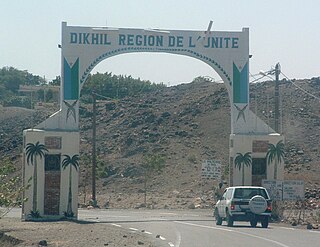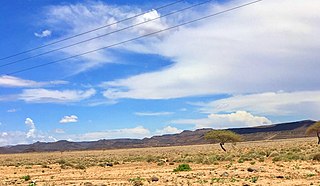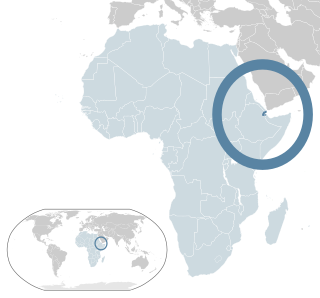This article relies largely or entirely on a single source .(December 2018) |
 |
| Part of a series on the |
| Culture of Djibouti |
|---|
| Culture |
| People |
| Religion |
| Language |
| Politics |
The cinema of Djibouti refers to the film industry in Djibouti.
This article relies largely or entirely on a single source .(December 2018) |
 |
| Part of a series on the |
| Culture of Djibouti |
|---|
| Culture |
| People |
| Religion |
| Language |
| Politics |
The cinema of Djibouti refers to the film industry in Djibouti.
Storytelling is an ancient custom in the culture of Djibouti. Love of cinema is but a modern, visual incarnation and continuation of this well-established tradition. The earliest forms of public film display in Djibouti were in French. In the 1920s, the first local movie theaters opened, during a time when Djibouti City was growing in size. [1] Film theaters became a place where local residents could watch movies in a relaxed atmosphere. With the development of the local film industry, additional theaters were launched. Among these establishments was the Eden in 1934, Olympia in 1939, Le Paris in 1965, and Al Hilal in 1975.
During the 1970s, the capital city had five movie theaters, with one in each district. Some local film making attempts were carried out with local actors. One was Burta Djinka, a 1972 film in Somali directed by G. Borg. [2] Following independence in 1977, a growing number of government-owned production and distribution companies as well as actual projection theaters sprang up.
In the 1990s two of the biggest cinemas, Odeon and Olympia, closed their doors. [1]

A movie theater, cinema, or cinema hall, also known as a movie house, picture house, the movies, the pictures, picture theater, the silver screen, the big screen, or simply theater is a building that contains auditoria for viewing films for public entertainment. Most, but not all, movie theaters are commercial operations catering to the general public, who attend by purchasing tickets.

The Olympia is a concert venue in the 9th arrondissement of Paris, France, located at 28 Boulevard des Capucines, equally distancing Madeleine church and Opéra Garnier, 300 metres (980 ft) north of Vendôme square. Its closest métro/RER stations are Madeleine, Opéra, Havre – Caumartin, and Auber.

A drive-in theater or drive-in cinema is a form of cinema structure consisting of a large outdoor movie screen, a projection booth, a concession stand, and a large parking area for automobiles. Within this enclosed area, customers can view movies from the privacy and comfort of their cars. Some drive-ins have small playgrounds for children and a few picnic tables or benches.

Cinema of Colombia refers to the film industry based in Colombia. Colombian cinema began in 1897 and has included silent films, animated films and internationally acclaimed films. Government support included an effort in the 1970s to develop the state-owned Cinematographic Development Company which helped produce some films yet struggled to stay financially viable. FOCINE went defunct in 1993. In 1997 the Colombian congress approved Law 397 of Article 46 or the General Law of Culture with the purpose of supporting the development of the Colombian film industry by creating a film promotion mixed fund called Corporación PROIMAGENES en Movimiento. In 2003 Congress also approved the Law of Cinema which helped to restart the cinematographic industry in Colombia.

Dikhil is a town in the western Dikhil Region of Djibouti. Lying east of Lake Abbe, It is situated about 122 km (76 mi) southwest of Djibouti City and 12 km (7.5 mi) north of the border with Ethiopia. It serves as the administrative centre of the Dikhil Region, and is home to the Afar and Somali ethnic groups. The town develops gardens and fruit trees.

The Cinema of the Philippines began with the introduction of the first moving pictures to the country on August 31, 1897, at the Salón de Pertierra in Manila. The following year, local scenes were shot on film for the first time by a Spaniard, Antonio Ramos, using the Lumiere Cinematograph. While most early filmmakers and producers in the country were mostly wealthy enterprising foreigners and expatriates, on September 12, 1919, Dalagang Bukid , a movie based on a popular musical play, was the first movie made and shown by Filipino filmmaker José Nepomuceno. Dubbed as the "Father of Philippine Cinema," his work marked the start of cinema as an art form in the Philippines.

Yoboki is a town located in the western Dikhil Region of Djibouti. It is situated approximately 179 km (111 mi) west of the nation's capital city of Djibouti, and roughly 59 km (37 mi) northwest of Dikhil, the regional capital.

Middle Eastern Cinema collectively refers to the film industries of Western Asia and part of North Africa. By definition, it encompasses the film industries of Egypt, Iran, Bahrain, Iraq, Israel, Jordan, Kuwait, Lebanon, Palestine, Oman, Qatar, Saudi Arabia, Syria, United Arab Emirates, and Yemen. As such, the film industries of these countries are also part of the cinema of Asia, or in the case of Egypt, Africa.

The cinema of Indonesia refers to film produced domestically in Indonesia. The Indonesian Film Board defines Indonesian film as "movies that are made by or using Indonesian resources whose Intellectual Property Right is owned either entirely or partly by Indonesian citizen or Indonesian legal entity".

The cinema of Somalia refers to the film industry in Somalia. The earliest forms of public film display in the country were Italian newsreels of key events during the colonial period. In 1937 the film Sentinels of Bronze was produced in Ogaden Somalia, with nearly all Somali actors. Growing out of the Somali people's rich storytelling tradition, the first few feature-length Somali films and cinematic festivals emerged in the early 1960s, immediately after independence. Following the creation of the Somali Film Agency (SFA) regulatory body in 1975, the local film scene began to expand rapidly. In the 1970s and early 1980s, popular musicals known as riwaayado were the main driving force behind the Somali movie industry. Epic and period films as well as international co-productions followed suit, facilitated by the proliferation of video technology and national television networks. In the 1990s and 2000s, a new wave of more entertainment-oriented movies emerged. Referred to as Somaliwood, this upstart, youth-based cinematic movement has energized the Somali film industry and in the process introduced innovative storylines, marketing strategies and production techniques.
The cinema of Saudi Arabia is a fairly small industry that only produces a few feature films and documentaries every year.

The Djiboutians are the people inhabiting or originating from Djibouti. The country is mainly composed of two ethnic groups, the Somali and the Afar. It has many languages - though Somali and Afar are the most widely spoken ones, Arabic and French serve as the official languages. There is a small Djiboutian diaspora in North America, Europe, and Australia.
Front de Libération de la Côte des Somalis was a nationalist organization, and later a guerrilla group, in the French Territory of the Afars and the Issas in present-day Djibouti. It competes with the Djibouti Liberation Movement (MLD), supported by Ethiopia. The FLCS was recognized as a national liberation movement by the Organization of African Unity (OAU), which participated in its financing.

The Grand Bara, Bara Wein or Bada Wein, is a desert in southern Djibouti. It consists of large areas of sand flats, with sparse, semi-desert and desert grasses and scrub vegetation. A road built in 1981 passes through the area, connecting the capital Djibouti City with the south. Prior to the arrival of the French, the extremely arid interior was inhabited primarily by the Issa Somali. Runners make their way across the Grand Bara Desert during the Annual Grand Bara 15K race.

Balbala is a southern suburb of Djibouti City, located west of the river Ambouli. The name is from the "Flashing" from the nearby lighthouse. The suburb has formed since 1966 when access to the city was restricted. At first a shanty town, it is now a suburb with schools and a hospital, and a population estimated at 80,000.

The cinema of Bhutan is a small but emerging industry, having started in the mid-1990s. It has since been supported by government officials and different businesses.

Pierre-Marie-Élie-Louis Nouailhetas (1894–1985) was a French naval officer who served as the governor (gouverneur) of French Somaliland from 7 August 1940 until 21 October 1942 during World War II.
Omar Osman Rabe was a Somali scholar, writer, politician and pan-Somalist of the former Cote Francaise des Somalis or French Somaliland and the Republic of Djibouti. He was born in Dembel in the Shinile region of Ethiopia in 1946 and died in Cairo, Egypt in 2013.

Abdallah Abdoulkader Abass, (1963–2007) was a well-known Djiboutian songwriter, composer and singer. He remains among the most famous Afar singers in Djibouti. Abdallah had a significant influence on newer generations of Djiboutian musicians in the 1980s and 1990s.

In the history of the Jews in Djibouti, the Jews of Djibouti are classified as part of the wider Yemenite Jewish community similar to those in Eritrea and Aden. Originally settling in Obock, and finally Djibouti City, in the wake of the British succession of the Gulf of Tadjoura to the French in 1884. The vast majority of the community made aliyah to Israel in 1949.